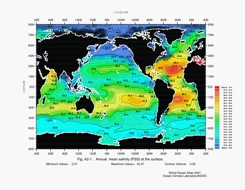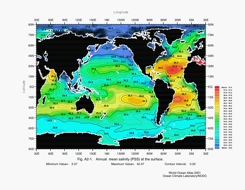There has always been evidence supporting the interaction between the atmosphere and the ocean and the interdependence of the two, so no declaration of such findings is going to come as any sort of shock.
However recently findings by Durack et al 2012 that were published in Science that presented the relationship between the two, has raised a head or two within the climate science world.
It is universally accepted that the oceans plays an intricate part in the existence and perpetuation of the atmosphere, for one they are the atmosphere’s primary source of moisture, over and above this the oceans have a discerning effect on a multitude of internal variations such as the El Nino southern Oscillation for example. There is also the argument that ocean is blue because the sky is blue and it is a reflection, or vice versa, depending on who you’re talking to and how old they are.
In the article by Durback et al 2012, the simple known processes are explored; precipitation over the ocean results in a desalination as a result of dilution, at the same time oceans in regions where evaporation over the water is significantly higher than the rainfall received, are seen to experience an increase in salt content. This is the basis of Duracks findings that “if there is a systematic increase in rainfall over some regions and enhanced evaporation in others, this is bound to leave a fingerprint pertaining to the increased and decreased salinity expected in the respective regions” (Durback et al 2012)
The findings of Durback can be seen to mimic those of Giorgi et al, who through use of earlier model-based suggestions, surmised the now popular term of “dry regions will get drier, whilst wet regions will become drier” (Giorgi et al 2012). Durback et al based their study on surface salinity measurements, which they gained through ARGO floats. These they then combined with sparser historical data over a 50 year period. (Durack et al 2010). The aim was to analyse the change within the spatial structure in terms of linear regressions against the control period. What Durback et al noted was that the variation in salinity was consistent with a prediction of a strengthening hydrological cycle of a magnitude of 8%/0C.
Furthermore they studied their results against both the global climate model simulations (involving a coupling of atmospheric-ocean models) and ocean model simulations (forced by atmospheric data). It should be noted here that ocean models are grounded in the laws of physics, and employ these laws in order to describe how water masses mix, how ocean currents flow and collectively how these processes affect both temperature and salinity.
The most defining inputs for ocean models are undoubtedly rainfall, evaporation and wind forcing, the models results although similar to observation in projected picture, happen to display an underestimation of the speed up in hydrological cycle as predicted by Durback et al 2012. Durback et al (2012) took to looking at projections for the future and as such were able to assess certain point to a intensification of significance (16 – 24%), this means that the intensification of the water cycle that will occur will do so in a world that is warmed than the current state by 20 – 30C.

The mean surface salinity of the world oceans. Source: http://serc.carleton.edu/eslabs/corals/4c.html
This does not bode well for the future however, an increase in the overall temperature of the Earth is set to be accompanied by both an increase in rainfall intensity as well an increase in length of dry spells according to the region in question (Giorgi et al 2011). There is also resounding evidence shown by (Benestad et al 2012) that the increase in rainfall intensity is more likely than not expected to be followed by more extreme rainfall amounts. On this information one can surmise that more extremes in both droughts and floods can undoubtedly be expected.
Although Durback et al 2012 did provide an addition to the ongoing investigation into climate change, the findings were not completely new, the last IPCC report has previously concluded an enhancement in the water cycle, this they based on observed ocean salinity changes. This I tend to believe is a positive, not in terms of what the future holds but in terms of where our models are directing us. Any correlation in predictions or projections from varying sources, should undoubtedly be viewed in a positive light, for it leads us to assume that evidentiary support must be mounting. Thus although method and conclusion may not be new, the Argo data used, manage to confirm earlier findings and in so doing they essentially strengthen previous observations: thus it cannot be denied that there exists a close and entwined relationship between the hydrological cycle and global warming.

cbrodrick
Just to clarify the error in the phrase used in the above post for the unsuspecting readers: it should read “dry regions will become drier and wet regions will become wetter”.
As the author has mentioned, the physical findings that form the foundation of Durack et al.’s paper are not exactly ground-breaking; however, I believe that the strength of the paper lies in one of the key take-home messages, being: “A change to freshwater availability in response to climate change poses a more important risk to human societies and ecosystems than warming alone.” (Durback et al., 2012).
Stefaan Conradie
An interesting result, but I remain sceptical (please not climate ‘sceptics’, this means I do not explicitly state that the method is inaccurate or wrong, but feel that there is evidence to suggest other approaches may be required in order to obtain accurate results) about the use of ‘linear regression’ in relation to interactions between temperature change and the hydrological cycle, there is too much non-linearity in the system and the regional variability in the system implies that many areas are at or near non-linear thresholds in the system (think of the description of melting in Critical Mass, for example, and the fact that ice melting is occurring and likely to influence changes in the hydrological cycle). For future projections of the observations, I would certainly question extrapolating observed trends to a 16-24% change in the intensity of rainfall with a 2-3°C projected increase in global mean temperatures.